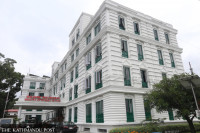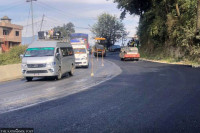National
Experts say Doklam standoff opens avenue for Nepal to settle its boundary issues
Amid a seven-week military standoff between India and China over Doklam plateau, Beijing on Tuesday upped the ante, with the Press Trust of India quoting a senior Chinese official as saying “what New Delhi would do if China enters Kalapani region in Uttarakhand or Kashmir”.
Anil Giri
Amid a seven-week military standoff between India and China over Doklam plateau, Beijing on Tuesday upped the ante, with the Press Trust of India quoting a senior Chinese official as saying “what New Delhi would do if China enters Kalapani region in Uttarakhand or Kashmir”.
The statement given by Wang Wenli, deputy director general of the Boundary and Ocean Affairs of China’s Ministry of Foreign Affair, to an Indian media delegation in Beijing has drawn the attention of experts in Nepal.
“The Indian side has also many tri-junctions. What if we use the same excuse and enter the Kalapani region between China, India and Nepal…,” said Wang. “Therefore, using the tri-junction as an excuse does not hold water at all. It will only cause more trouble,” Wang said, creating enough ripples in Kathmandu as to whether Kalapani was on its way to become another Doklam.
During Matrika Prasad Koirala’s prime ministership in 1952, Nepal allowed India to station its troops in Kathmandu and Nepal’s northern border, including Kalapani. India later withdrew from other posts and stationed its troops on its side of the border of Kalapani. But later the Nepali territory was encroached upon, making Kalapani a disputed area between Nepal and India.
When India and China agreed in 2015 to expand a trade route through Lipulek Pass near Kalapani, Kathmandu was kind of caught unawares, and foreign policy experts have consistently called into question Nepali leadership’s acumen and wherewithal to deal with the situation.
The then government did write to both Delhi and Beijing about the agreement, but we never received satisfactory responses, say government officials.
In the past, Nepali survey officials have presented verified maps showing Kalapani as a part of the Nepali territory, but it continues to be a disputed area. Now that the Doklam standoff is at its peak, with coercive diplomacy on display from both India and China, and the latter even bringing in Kalapani between them, experts say it is high time Nepal raised the issue so as to avoid any border/ diplomatic standoff with neighbouring countries.
According to experts, Nepal now has a perfect opportunity to raise its issues, as Kathmandu will be hosting two high-profile guests from the south and the north in the coming week.
India’s External Affairs Minister Sushma Swaraj is arriving on Thursday. Chinese Vice Premier Wang Yang will be visiting Nepal from August 14. During their stay in Kathmandu, both are scheduled to hold talks with Prime Minister Sher Bahadur Deuba, who is set to embark on a state visit to India on August 23.
“We missed an opportunity to communicate our concerns properly when India and China agreed to expand the border trade through the Lipulek Pass,” said Ramesh Nath Pandey, a former foreign minister. “We have failed to learn from our past experiences. The problem with us is we have trust deficit with our neighbours. It’s high time we started working on confidence building with both our neighbours as we take up such sensitive issues.”
Narayan Kaji Shrestha, also a former foreign minister, said though Nepal and India have agreed to settle the disputed areas in Kalapani and Susta, there has been no progress in the past several years.
A joint technical team has prepared 182 strip maps between Nepal and India besides Kalapani and Susta. Nepal is for signing the boundary maps after completing demarcation of Susta and Kalapani, but the two countries are yet to arrive at a meeting point.
“Now time has come to settle the boundary dispute within the given time frame. The boundary demarcation should be completed. We should talk to both India and China about our land,” he said.
Shrestha, however, was cautious whether Nepal should raise the issue at a time when India and China are locked in a standoff in Doklam. “But this does not mean we should never raise the issue. Talks must continue at the top political level.”




 13.98°C Kathmandu
13.98°C Kathmandu









%20(1).jpg&w=300&height=200)





